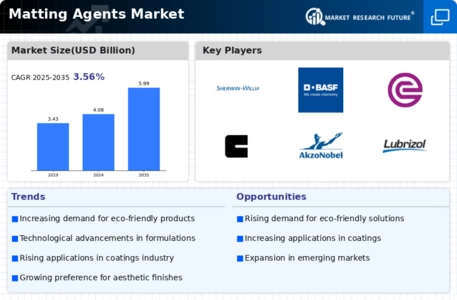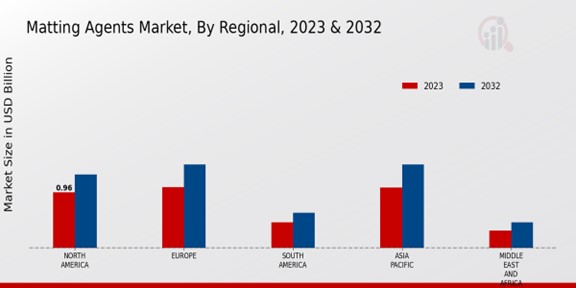Market Growth Projections
The Global Matting Agents Market Industry is poised for substantial growth, with projections indicating a compound annual growth rate (CAGR) of 3.55% from 2025 to 2035. This growth is driven by various factors, including increasing demand across multiple sectors and the continuous innovation of matting agents. As the market evolves, it is anticipated that the total market value will reach approximately 5.99 USD Billion by 2035. This upward trend reflects the industry's resilience and adaptability in meeting changing consumer preferences and regulatory requirements. The positive outlook for the market underscores the importance of matting agents in enhancing product performance and aesthetic appeal.
Rising Environmental Awareness
Increasing environmental awareness among consumers and regulatory bodies significantly impacts the Global Matting Agents Market Industry. There is a growing emphasis on sustainability, leading manufacturers to seek eco-friendly alternatives to traditional matting agents. This shift is prompting the development of bio-based and biodegradable matting agents that align with green chemistry principles. As regulations tighten and consumers demand more sustainable products, companies are compelled to adapt their formulations accordingly. This trend not only supports environmental goals but also opens new market opportunities for innovative matting agents that meet these criteria. The focus on sustainability is likely to be a key driver of market growth in the coming years.
Expansion in the Cosmetics Sector
The cosmetics industry significantly influences the Global Matting Agents Market Industry, as the demand for matte finishes in makeup products continues to rise. Consumers increasingly prefer products that offer a non-shiny appearance, prompting manufacturers to incorporate matting agents into formulations. This trend is particularly evident in foundations, powders, and lip products, where a matte finish is often associated with a more sophisticated look. As the market evolves, the integration of innovative matting agents that enhance product performance and stability is likely to drive growth. The cosmetics sector's expansion is expected to contribute to the overall market growth, with projections indicating a potential increase to 5.99 USD Billion by 2035.
Growing Demand in Coatings and Inks
The Global Matting Agents Market Industry experiences a notable surge in demand driven by the coatings and inks sector. As manufacturers increasingly seek to enhance the aesthetic appeal and performance of their products, matting agents play a crucial role in achieving desired surface finishes. In 2024, the market is projected to reach 4.08 USD Billion, reflecting the industry's focus on quality and innovation. The trend towards eco-friendly and sustainable formulations further propels the adoption of matting agents, as companies strive to meet regulatory standards and consumer preferences. This growth trajectory suggests a robust future for matting agents in coatings and inks.
Diverse Applications Across Industries
The versatility of matting agents across various industries underpins the growth of the Global Matting Agents Market Industry. These agents find applications in coatings, inks, plastics, cosmetics, and more, showcasing their adaptability to different formulations and end-use requirements. This diversity allows manufacturers to tap into multiple markets, thereby expanding their customer base and revenue streams. For instance, the automotive and construction sectors increasingly utilize matting agents to achieve specific aesthetic and functional properties in their products. As industries continue to evolve and seek innovative solutions, the demand for matting agents is expected to rise, contributing to a steady growth trajectory.
Technological Advancements in Product Development
Technological advancements play a pivotal role in shaping the Global Matting Agents Market Industry. Innovations in formulation chemistry enable the development of more efficient and effective matting agents, which cater to diverse applications across various industries. These advancements not only enhance the performance of matting agents but also allow for the creation of products that meet specific customer requirements. For instance, the introduction of new polymer-based matting agents has improved compatibility with a range of solvents and resins, thereby broadening their applicability. As companies invest in research and development, the market is likely to witness an influx of novel products, further driving growth and diversification.




















